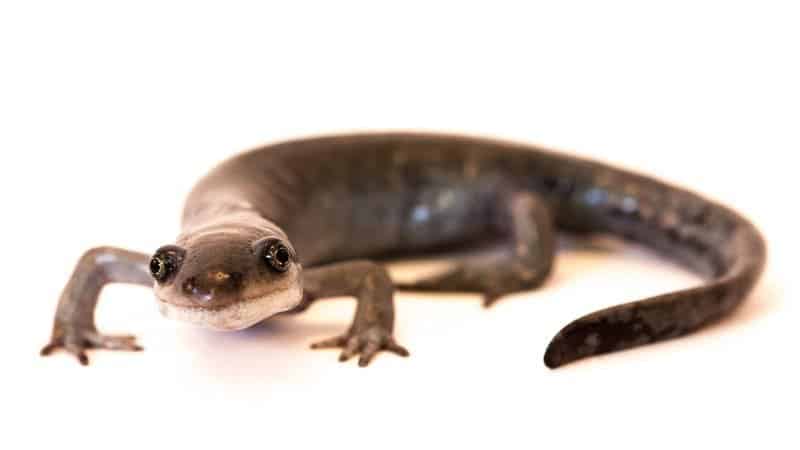
Mole salamanders are stout-bodied salamanders endemic to North America which are fascinating for a variety of reason. For one, their short stubby arms and little faces with protruding cartoonish eyes makes them some of the cutest amphibians you’ll see. They’re also facultatively paedomorphic, meaning that they may retain larval characteristics as adults and continue to live in the water or metamorphosis and lead a terrestrial life. In other words, these Peter Pans can choose whether or not to become adults. And it gets weirder.
Sex: more than meets the eye
One mole salamander variety is comprised of all females which reproduce asexually by cloning. This strategy seems successful given the unisexual mole salamanders have been around for six million years but one recent study suggests these adorable critters might be at a disadvantage compared to their sex-driven cousins in the face of climate change. Simply put, not having sex makes them lazier, the study seems to conclude.
In Europe, an invasive pathogenic fungus (Batrachochytrium salamandrivorans; Bsal) is wreaking havoc for the salamander and newt biodiversity. In 2016, the U.S. federal government embargoed 201 species to keep amphibians potentially infected with the skin-eating diseases from starting an outbreak at the other end of the pond as well. Despite these best efforts, the fungus might end up infecting North American species. Moreover, climate change and habitat fragmentations make amphibian populations in the U.S. even more vulnerable.
Bearing these threats in mind, biologist Rob Denton and colleagues from Ohio State University are studying the various reproduction strategies of mole salamanders to see what are the advantages and disadvantages for each.
“Salamander-specific chytrid (Bsal) fungus is a huge concern here in the United States, because we have such a wonderful hotbed of salamander diversity compared to the rest of the world,” Dentold told The Smithsonian. “Preventing that outbreak from happening here is really important and part of that is understanding the differences on a species level between these animals—how they interact with each other and how they interact with their landscape.”
The unisexual salamanders, known as Ambystoma, do have a “little bit” of sex, to be fair. When the weather is ripe, meaning wet (they love the rain), these females will come in contact with pockets of sperm deposited by males from either of the five known mole salamander species. “Usually that sperm is just used to tell their body, ‘hey, it’s time to make eggs,’” Denton says. “Sometimes that sperm genome actually sneaks into that next generation,” he added. No one knows yet how this happens.
To test whether this cloning evolutionary strategy is more advantageous than the procreating variety, the researchers placed 17 small-mouth salamanders and 21 unisexual individuals on a treadmill. Every three minutes, the salamanders were given a break from their workouts after a researcher would flip them on their backs. The time it took for each salamander to rebound on their feet was recorded. The longer it took, the more tired the salamander was, the researchers reckoned. This experiment revealed that the sexual salamanders could travel four times the distance asexual salamanders could.
The team then left the lab to assess fitness in the wild. Mole salamanders spend all of their early life in shallow poles from which they emerge only after they’ve metamorphosized from their humble tadpole beginnings. Once they become adults, the sexual salamanders will do some soul searching but, ultimately, will return back to their original breeding pools where they were born to lay eggs. It follows that in any given pond you’ll find a similar genetic makeup.
However, some small-mouth salamanders will break the pattern and land in other pools. So Denton and colleagues set up traps in ponds formed by melted snow and using samples collected from captive individuals they mapped the diversity of the pond. This told them how far an individual between ponds and how it compared to the unisexuals.
The results suggest that in the wild small-mouth salamanders travel twice and a half as far as their counterparts, as reported in the journal Functional Ecology.
Not having sex has its perks. For instance, the unisexual salamanders go out less and hence the risk of catching an infectious disease, like Bsal, drops. On the flipside, it’s genetic diversity that could help these salamanders if an outbreak occurs. This is how Tasmanian devils were able to rebound in the face of evil facial tumor disease (DFTD), an 100% kill rate disease which wiped out 80 percent of the population. Then there’s climate change which affects habitats and available resources. If their habitat dries up, unisexual mole salamanders might not make it but their sexual counterparts might, simply because they’re less lazy it seems. So there’s more to sex than meets the eye.
“Maybe the best explanation for why sexual salamanders travel so far is because they have to: On a large landscape with few places to breed, the animals that can cross that distance are the ones that survive and reproduce,” Denton said.
“Perhaps the more interesting question is why the all-female salamanders don’t go very far, and we think that has to do with the physiological costs of not having sex. Essentially, not mixing up your genomic material often enough likely causes some problems for genes that you need to make energy.”






